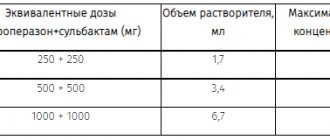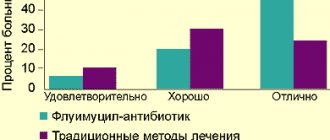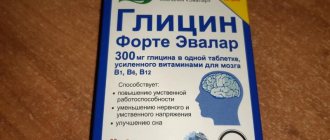Pharmacodynamics and pharmacokinetics
The active ingredient of the drug belongs to the group of sulfonamide antimicrobial drugs. Sulfadimezin is a short-acting drug.
What is Sulfadimezin used for? The medicine is effective against gram-positive and -negative microorganisms. Namely: cocam , Escherichia coli , Klebsiella , the causative agent of anthrax , shigellosis , gas gangrene , plague , pneumonia , chlamydia , the causative agent of toxoplasmosis .
The drug has a bacteriostatic effect. Sulfadimidine inhibits the synthesis of dihydropteroate synthetase through a competitive mechanism, thus disrupting the conversion of tetrahydrofolic acid into purine and pyrimidine bases.
The drug is well adsorbed in the gastrointestinal tract , mainly in the small intestine. The degree of binding to plasma proteins is 75-86%. The active substance penetrates well into various tissues and fluids of the body and is easily and relatively quickly eliminated. Metabolic reactions occur in the liver tissue. The half-life of metabolites is 7 hours. The drug is excreted through the kidneys.
Sulfadimethoxine
Sulfadimethoxine is an antimicrobial drug from the sulfonamide group. It has a long-lasting effect. It exhibits competitive antagonism to para-aminobenzoic acid (the growth factor of many microorganisms), suppressing the activity of the enzyme dihydropteroate synthetase, which results in disruption of the formation of tetrahydrofolic acid involved in the synthesis of purine and pyrimidine bases. Sensitivity to the drug is demonstrated by staphylococci, streptococci (including pneumococci), Klebsiella, Escherichia coli, Shigella, and chlamydia. After oral administration, it penetrates into the blood within half an hour. Peak plasma concentrations are achieved within 8-12 hours. To achieve therapeutic concentrations, the drug is taken in a dose of 1-2 g on the first day and in a half-reduced dose on subsequent days. It interacts with plasma proteins, which ensures its accumulation in the bloodstream. Has good penetrating ability (except for the blood-brain barrier). Indicated for infections caused by organisms sensitive to the drug: acute inflammation of the components of the lymphatic pharyngeal ring (mainly the tonsils), inflammation of the maxillary (maxillary) paranasal sinus, inflammatory processes in the middle ear, bronchi, dysentery, inflammation of the urogenital and biliary elements tract, erysipelas, infections in accidental or surgical wounds, chlamydial eye infection, characterized by damage to the conjunctiva and cornea. Frequency of administration: once a day after meals. The duration of the medication course is 7-10 days. Possible undesirable side reactions: cephalalgia, dyspepsia, painful sensation in the epigastric region, chest, oral cavity and pharynx, preceded by vomiting, vomiting, cholestatic syndrome, rash on the skin, increased body temperature without allergies (drug fever), leukopenia , agranulocytosis.
The drug is not used for individual intolerance to sulfonamide derivatives, suppression of hematopoiesis in the bone marrow, insufficiency of liver and/or kidney function, decompensated dysfunction of the myocardium of a chronic nature, genetically determined pathology associated with deficiency of glucose-6-phosphate dehydrogenase, porphyria, increased levels of nitrogenous substances in the blood metabolic products excreted by the kidneys, as well as during pregnancy. During a drug course using Sulfadimethoxine, it is necessary to increase fluid intake (mainly with an alkaline reaction), and ensure regular monitoring of the peripheral blood picture and functional indicators of the kidneys. Sulfadimethoxine weakens the effect of bactericidal (causing the death of microorganisms) antibiotics that act exclusively on dividing bacteria, including penicillins (benzylpenicillin sodium salt, Bicillin-1, Bicillin-5, ampicillin, amoxicillin, etc.), cephalosporins (cefazolin, cephalexin, cefotaxime, etc.). Local anesthetics such as novocaine, benzocaine and tetracaine inhibit the activity of the drug. Para-aminosalicylic acid and barbituric acid derivatives (phenobarbital), on the contrary, stimulate the antibacterial activity of the drug. Salicylic acid derivatives, methotrexate and phenytoin contribute to the manifestation of the toxic properties of Sulfadimethoxine. NSAIDs thioacetazone, chloramphenicol in combination with Sulfadimethoxine increase the risk of developing leukopenia and agranulocytosis. The drug potentiates the effects of indirect anticoagulants, sulfonamides, which reduce blood glucose levels. Sulfadimethoxine inhibits the effect of tablet contraceptives. The drug stimulates the metabolic biotransformations of cyclosporine.
Indications for use of Sulfadimezin
The medicine is prescribed for the treatment of diseases caused by microorganisms sensitive to it.
Indications for use:
- gonorrhea and trachoma ;
- toxoplasmosis;
- diseases of the genitourinary system ;
- infections of the respiratory tract, ears, throat, nose ( sore throat, otitis media, bronchitis, pneumonia, sinusitis, tonsillitis );
- erysipelas , pyoderma , various infectious diseases of the skin and soft tissues;
- shigellosis.
Content
- Characteristics of sulfadimezin (500 mg tablet No. 10)
Composition: 1 tablet contains: sulfadimidine 500 mg.
Excipients: potato starch, talc, stearic acid, polysorbate 80.
Tablets are white or white with a slightly yellowish tint, flat-cylindrical, chamfered and scored.
Pharmacological Action: Antimicrobial bacteriostatic agent, sulfonamide.
The mechanism of action is due to competitive antagonism with para-aminobenzoic acid, inhibition of dihydropteroate synthase, disruption of the synthesis of tetrahydrofolic acid, necessary for the synthesis of purines and pyrimidines.
Active against gram-positive and gram-negative cocci, Escherichia coli, Shigella spp.
, Klebsiella spp.
, Vibrio cholerae, Clostridium perfringens, Bacillus anthracis, Corynebacterium diphtheriae, Yersinia pestis, Chlamydia spp.
, Actinomyces israelii.
Indications for Use: Infectious and inflammatory diseases caused by microorganisms sensitive to the drug: - tonsillitis; - sinusitis; - otitis media; - exacerbation of chronic bronchitis; - pneumonia; - inflammatory diseases of the biliary and urinary tract; - shigellosis; - erysipelas; - wound infection .
Directions for Use: Take orally.
Pneumonia For adults - 2 g are prescribed for 1 dose, then 1 g 4-6 times a day.
For children over 3 years old - 0.
1 g/kg for the first dose, then 0.1-0.15 g/kg/day, divided into 4-6 doses.
The drug is stopped 2-3 days after the symptoms of the disease disappear.
Tonsillitis For adults - 1 g 2-3 times a day; For children over 3 years old - 0.
05-0.
075 g/kg/day, divided into 2-3 doses.
Duration of therapy: 5-7 days.
Sinusitis For adults - 1 g 4-6 times a day; For children over 3 years old - 0.1-0.15 g/kg/day, divided into 4-6 doses.
Duration of therapy: 7-10 days.
Otitis media For adults - 1 g 2 times a day; For children over 3 years old - 0.05-0.075 g/kg/day, divided into 2 doses.
Duration of therapy: 7-10 days.
Exacerbation of chronic bronchitis For adults - 1 g 4-6 times a day; For children over 3 years old - 0.1-0.15 g/kg/day, divided into 4-6 doses.
Duration of therapy: 10-14 days.
Inflammatory diseases of the biliary and urinary tractFor adults - 0.
5 g 4-6 times a day; For children over 3 years old - 0.
05-0.
075 g/kg/day, divided into 4-6 doses.
Duration of therapy: 7-10 days.
Shigellosis: 2 courses of treatment are carried out.
First course: days 1 and 2 - 1 g every 4 hours (total 6 g/day), days 3 and 4 - 1 g every 6 hours (4 g/day), days 5 and 6 - 1 g every 8 hours (3 g/day).
After 5-6 days, a second course is carried out: days 1 and 2 - 1 g every 4 hours, at night - every 8 hours (total 5 g/day), days 3 and 4 - 1 g every 4 hours (4 g/day, do not give at night), day 5 - 3 g/day.
Erysipelas For adults - 1 g 4-6 times a day.
For children over 3 years old - 0.
1-0.
15 g/kg/day, divided into 4-6 doses.
Duration of therapy: 7-10 days.
Wound infections: For adults - 2 g for 1 dose, then 1 g 4-6 times a day.
For children over 3 years old - 0.
05-0.
075 g/kg/day, divided into 4-6 doses.
The duration of therapy for mild forms is 5-7 days, for severe forms it is about 10 days.
Higher doses For adults: - single dose - 2 g, daily dose - 7 g; For children over 3 years of age: daily dose - 0.
1-0.
15 g/kg.
Interaction: Reduces the effectiveness of bactericidal and antibiotics that act only on dividing microorganisms (including
h.
penicillins and cephalosporins).
Increases (mutually) the hematotoxicity of chloramphenicol, thiamazole.
Benzocaine and procaine reduce antimicrobial activity (during hydrolysis they release para-aminobenzoic acid).
Ascorbic acid and methenamine increase the risk of developing crystalluria.
Non-steroidal anti-inflammatory drugs, hypoglycemic drugs (sulfonylurea derivatives), phenytoin and coumarin anticoagulants increase the severity of the side effects of the drug (leukopenia, agranulocytosis).
Antacids reduce intestinal absorption.
For toxoplasmosis, combination with pyrimethamine is possible.
Myelotoxic drugs increase the manifestations of hematotoxicity of the drug.
Side Effects: Nausea, vomiting, crystalluria, allergic reactions, leukopenia, agranulocytosis.
Contraindications: - hypersensitivity (including to other sulfonamides); - inhibition of bone marrow hematopoiesis; - chronic renal failure; - azotemia; - congenital deficiency of glucose-6-phosphate dehydrogenase; - porphyria; - children under 3 years of age; - hyperbilirubinemia in children (risk of developing bilirubin encephalopathy).
With caution in patients with impaired liver function, with a history of allergic diseases.
Use during pregnancy and breastfeeding The drug is contraindicated for use during pregnancy and lactation (breastfeeding).
Special Instructions: During treatment, adequate fluid intake should be ensured due to the risk of developing crystalluria.
With long-term use, monitoring of peripheral blood parameters is necessary.
Influence on the ability to drive vehicles and operate machinery. Does not affect driving vehicles and engaging in potentially hazardous activities that require increased concentration and speed of psychomotor reactions.
Contraindications
The drug is contraindicated:
- if allergic to any of the components of the product, medications from the sulfonamide ;
- children under three years old;
- with inhibition of hematopoietic processes in the bone marrow;
- with azotemia , porphyria , renal failure ;
- if children under 18 years of age have hyperbilirubinemia ;
- with congenital deficiency of glucose-6-phosphate dehydrogenase .
Persons with liver problems or allergic diseases should exercise caution.
Side effects
Sulfadimezine may cause:
- pain in the abdominal area, indigestion , nausea, diarrhea , vomiting, stomatitis , pancreatitis , anorexia ;
- allergies , skin rashes, chills, urticaria , sensitivity to light, toxic epidermal necrolysis , anaphylactic and anaphylactoid reactions ;
- headaches , ataxia , convulsions, various neurological reactions , drowsiness , loss of consciousness, insomnia ;
- depression , hallucinations , vertigo , tinnitus, psychosis ;
- increased levels of liver enzymes, jaundice , hepatitis ;
- agranulocytosis , thrombocytopenia , purpura , leukopenia ;
- crystalluria , nephritis ;
- hypothyroidism , hypoglycemia ;
- sore throat, cough, tachycardia , vasculitis , muscle and joint pain.
Instructions for use of Sulfadimezine (Method and dosage)
Inside.
Depending on the disease and its course, the dosage and duration of treatment may vary significantly.
The average dosage for adults is 4 tablets at the first dose, and then 2 tablets 4-6 times a day. The maximum single dosage for an adult is 2 grams, daily dosage is 7 grams.
For children from three to 18 years of age, the dosage is calculated based on 0.1 g of the drug per kg of patient weight (primary). Then the dose is reduced to 0.025 g per kg of weight, every 4-8 hours. The maximum daily dosage is 0.15 g per kg of child weight.
Instructions for use of Sulfadimezin
For pneumonia, 2 grams are prescribed at the first dose, then 1 gram 4-6 times a day. For children - 0.1 grams per kg of weight in the first dose, then 0.15 g per kg per day, divided into 5 doses. The course of treatment is 2-3 days.
To treat otitis media, adults take 2 grams of the medicine in 2 divided doses per day. For children, the daily dosage is 0.075 g per kg of weight, in 2 doses. The duration of treatment is from a week to 10 days.
For tonsillitis, adults are prescribed 1 gram 2-3 times a day. For children, 0.075 grams per kilogram of body weight per day, in 2-3 doses. The duration of treatment is from 5 days to a week.
To treat sinusitis, use 4-6 grams of the drug per day, in 4-6 doses. Children are prescribed 0.15 g per kg per day, in 4-6 doses. The course of treatment is from a week to 10 days.
During an exacerbation of chronic bronchitis , adults should take 4-6 grams of medication per day, dividing it into 4-6 doses. For children – 0.15 g per kg per day, the frequency of administration is the same. The course of treatment in this case will be from 10 days to two weeks.
For inflammation of the biliary and urinary tract, adults are prescribed half a gram of the drug 4-6 times a day. Children - 0.05-0.075 g per kg per day, the frequency of administration is the same as for adults. The course of treatment is from a week to 10 days.
Treatment for shigellosis requires two courses of antibiotics .
During the first course, on days 1 and 2, take a gram of the drug every 4 hours. On days 3 and 4, drink a gram every 6 hours. On days 5 and 6, you need to take 3 grams per day, the frequency of administration is 8 hours.
After a five to six day break, taking the pills is resumed. On days 1 and 2, take 1 gram, every 4 hours during the day and every 8 hours at night. On days 3 and 4, drink 1 gram every 4 hours (do not take at night). During the 5th day of treatment, you need to consume 3 grams of the drug.
For wound infections, take 2 grams for the first time, then 1 gram 4-6 times a day. For children, daily dosage = 0.075 g per kg of weight, in 4-6 doses. For a mild form of the disease, the course of treatment ranges from 5 days to a week, for a severe form – 10 days.
For erysipelas, adults take 4-6 grams per day (1 gram in 6 doses). Children are given 0.15 g per kg of body weight per day. The course of treatment is from a week to 10 days.
Use of the drug Sulfadimidin
Orally, at the first dose - 2 g, then - 1 g every 4-6 hours until body temperature decreases, then - 1 g every 6-8 hours. Course dose - 20-30 g. Orally for dysentery - 6 g on days 1–2 (1 g every 4 hours), 4 g on days 3 and 4 (1 g every 6 hours) and 3 g on the 5th and 6th day (1 g every 8 hours). The course of treatment is 25-30 g. After a break (5-6 days), a repeat course is prescribed: on the 1st and 2nd days - 1 g 5 times a day, on the 3rd and 4th days - by 1 g 4 times a day and on the 5th day - 1 g 3 times a day; when repeating the course, 18–21 g of sulfadimidine is prescribed. Higher oral doses: single dose - 2 g, daily dose - 7 g. Children under 2 years of age - 0.2 g/kg per day; 3–4 years: one-time - 0.35 g, daily - 2 g; 5-6 years: one-time - 0.4 g, daily - 2.5 g, 7-14 years: one-time - 0.5 g, daily - 3 g.
Overdose
In case of overdose, the following are possible: anorexia , abdominal cramps, nausea, vomiting, headache , loss of consciousness and drowsiness . Pathological changes in the blood.
As therapy, you should immediately stop taking the drug, rinse the stomach, take large amounts of fluid, and symptomatic treatment.
If methemoglobinemia occurs, 1% methylene blue .
Hemodialysis is ineffective.
Interaction
The effect of the drug is weakened by the influence of benzocaine , pyrimethamine and procaine .
Sulfadimezin reduces the effectiveness of antibiotics , bactericidal agents that only affect dividing microorganisms. Such as cephalosporins or penicillins .
The combination of the drug with ascorbic acid and methenamine can increase the risk of crystalluria .
The drug increases the toxicity of thiamazole and chloramphenicol .
When taking the drug together with NSAIDs , hypoglycemic agents , phenytoin and coumarins , the risk of adverse reactions increases.
Drug interactions Sulfadimidine
Reduces the effectiveness of bactericidal antibiotics that act only on dividing microorganisms (including penicillins, cephalosporins). For toxoplasmosis, combination with chloridine is acceptable. Absorption in the intestine is reduced under the influence of antacids. While taking butadione, sulfonylurea derivatives, diphenin, neodicoumarin and other drugs with high affinity for blood plasma proteins, it is possible to displace sulfadimidine from binding with proteins and increase the concentration of its free fraction in the blood. High doses of ascorbic acid and hexamethylenetetramine (urotropine) increase the risk of crystal formation. Antimicrobial activity decreases in the presence of novocaine, as well as drugs containing PABA. Increases (mutually) the hematotoxicity of chloramphenicol, mercazolil.
List of pharmacies where you can buy Sulfadimidine:
- Moscow
- Saint Petersburg
special instructions
Due to the similarity of the chemical structure, if the patient is allergic to furosemide , carbonic anhydrase , thiazide diuretics , sulfonylurea derivatives , then taking Sulfadimezine can cause serious adverse reactions.
At the first sign of skin allergy, you should stop taking the product.
Previously, deaths have been reported due to the body's reaction to the drug. This has occurred due to Stevens-Johnson syndrome , toxic epidermal necrolysis , agranulocytosis and aplastic anemia .
When prescribing the medicine to persons suffering from severe forms of allergies , liver and kidney diseases, diabetes mellitus , bronchial asthma or over 65 years of age, special care should be taken.
To avoid the occurrence of crystalluria , you must drink plenty of fluids during treatment with the drug.
With long-term use, you need to periodically monitor your blood test results.





